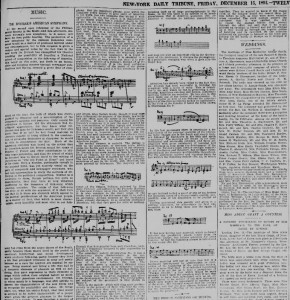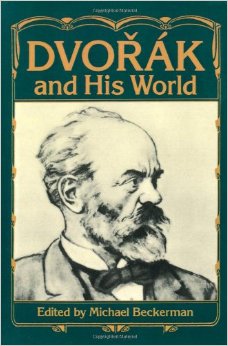When Czech composer Antonín Dvořák came to the United States near the end of 1892, he was met with welcoming arms in the musical community. With a salary at the National Conservatory of about 3 times that of a U.S. Senator, it’s fairly easy to see he was wanted in America.1 There is some evidence of his popularity in some personal correspondence to Dvořák which I found in Dvořák and His World while perusing the Halvorson Music Library at St. Olaf College.2
Among the letters sent to him are those written by amateur musicians, requesting feedback on scores, thanking him for his compositions, and asking for rights to perform his published works. However, digging through the letters, I found some rather interesting ones. One group of letters that caught my attention was by that of an Auguste Roebbelen of the New York Philharmonic Society. He requested that the orchestra perform his newest work, the “New World Symphony” that year (1893) in December.2 A letter on January first of 1894 confirmed that they did receive permission, and he says that the concert
“was epochal in its character, for it was the first production of a new work, by one of the greatest composers, written in America, embodying the sentiment and romance derived from a residence in America and a study of its native tone-expressions.”
These “native tone-expressions” link back to an earlier letter in this volume sent to Dvořák by a music critic and writer Henry Krehbiel. Thanking him for the permission to do the notes on his symphony, and providing him with “3 more Negro songs from Kentucky” in case Dvořák wished to use them while working on his new quartet and quintet. This interested me, and I followed the rabbit hole further, tracking down the original notes that Krehbiel wrote on the premier of the New World Symphony.
On December 15, 1893  Krehbiel wrote an extensive analysis and explanation of The New World Symphony in the daily publication of the New-York Tribune. In the article, he seems to capture words that Dvořák had said to him during their interview, noting that the melody of the second movement Largo is inspired by Henry Wadsworth Longfellow’s epic poem, The Song of Hiawatha. His article even mentions the work of Alice Fletcher, who worked on transcribing and notating Native American music in the later 1800’s. All in all, it’s amazing to see what sort of influences other people could have on Dvořák or the music he composed. Letters from an orchestral society allowed them to play piece of his that hadn’t been published yet. The request for writing notes by Krehbiel gave him an interview which eventually led to my knowledge of what inspired Dvořák for a small portion of his symphony. These letters set the stage for what we now know of Dvořák: a man who took melodies from truly American tradition, whether positive or negative, and insisted that they be used for the core of American music. Continue reading
Krehbiel wrote an extensive analysis and explanation of The New World Symphony in the daily publication of the New-York Tribune. In the article, he seems to capture words that Dvořák had said to him during their interview, noting that the melody of the second movement Largo is inspired by Henry Wadsworth Longfellow’s epic poem, The Song of Hiawatha. His article even mentions the work of Alice Fletcher, who worked on transcribing and notating Native American music in the later 1800’s. All in all, it’s amazing to see what sort of influences other people could have on Dvořák or the music he composed. Letters from an orchestral society allowed them to play piece of his that hadn’t been published yet. The request for writing notes by Krehbiel gave him an interview which eventually led to my knowledge of what inspired Dvořák for a small portion of his symphony. These letters set the stage for what we now know of Dvořák: a man who took melodies from truly American tradition, whether positive or negative, and insisted that they be used for the core of American music. Continue reading

